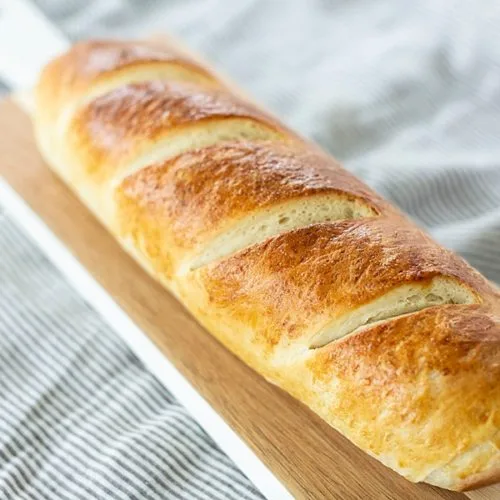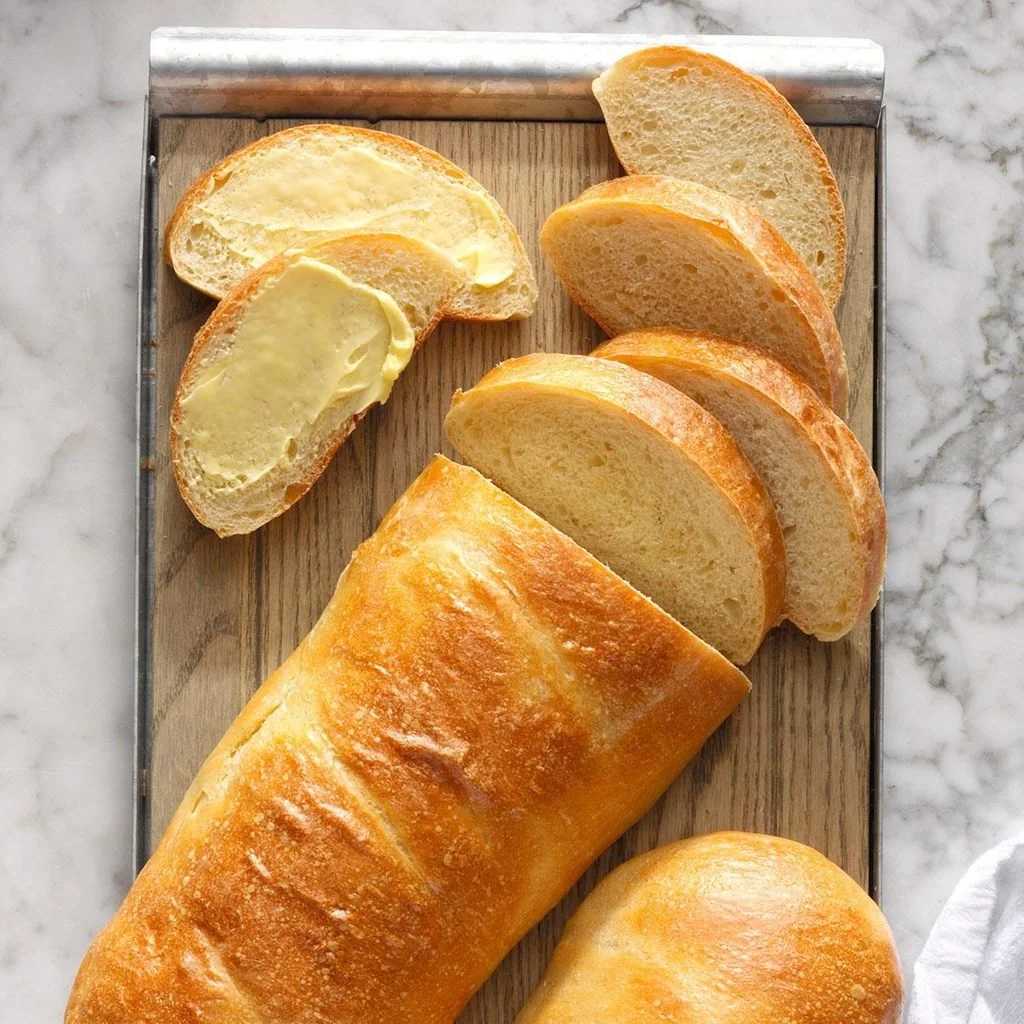So, you’ve decided to embark on the noble quest of creating your own Sourdough French Bread. Well, aren’t you just a baking superhero? Get ready to dive into the world of tangy, crusty goodness as you follow this tried-and-true recipe.
But before you start dreaming of warm bread straight out of the oven, there are a few secrets and techniques that will make all the difference. Stay tuned, because we’re about to reveal the key to achieving that perfect, airy crumb and the most irresistible aroma that will make everyone around you weak in the knees.
Contents
- 1 Key Takeaways
- 2 Gathering the Ingredients
- 3 Preparing the Sourdough Starter
- 4 Mixing and Kneading the Dough
- 5 Proofing and Shaping the Loaves
- 6 Baking the Bread
- 7 Sourdough French Bread Recipe
- 8 Enjoying the Homemade Sourdough French Bread
- 9 Nutrition facts
- 10 Frequently Asked Questions
- 10.1 How Many Servings Does This Sourdough French Bread Recipe Yield?
- 10.2 Can I Use Instant Yeast Instead of Sourdough Starter?
- 10.3 Can I Substitute Whole Wheat Flour for All-Purpose Flour in This Recipe?
- 10.4 How Long Does the Sourdough Starter Need to Ferment Before It Is Ready to Use?
- 10.5 Can I Freeze the Baked Sourdough French Bread for Later Use?
- 11 Conclusion
Key Takeaways
- Creating a sourdough starter from scratch using equal parts flour and water in a sterilized glass jar.
- Proper mixing techniques and kneading duration are essential for achieving the desired texture of the bread.
- Proofing and shaping the loaves correctly, including pre-shaping into round balls and final shaping by flattening and rolling tightly.
- Baking the bread at the right temperature, using steam to develop a crispy crust, and rotating the loaves for even color.
Gathering the Ingredients
To gather the ingredients for your sourdough French bread, start by checking that you have all the necessary items on hand. First, let’s discuss sourdough starter alternatives. If you don’t have a sourdough starter ready, don’t worry! You can create a sourdough starter from scratch using just flour and water. Simply mix equal parts of flour and water in a sterilized glass jar and let it sit at room temperature for a few days, stirring it occasionally. This will create a natural fermentation process, and you’ll have a homemade sourdough starter.
Now, let’s talk about where to buy quality ingredients. When it comes to making sourdough French bread, using high-quality ingredients is essential for achieving the best flavor and texture. Look for organic bread flour, which has a higher protein content, resulting in a better rise and chewier texture. You can find organic bread flour at your local health food store or online.
For the water, it’s best to use filtered or spring water to avoid any chemicals or impurities that could interfere with the fermentation process. If you prefer, you can also use bottled water.
Preparing the Sourdough Starter
To prepare the sourdough starter, begin by mixing equal parts of flour and water in a sterilized glass jar. This simple mixture will act as the foundation for your sourdough bread. Once combined, cover the jar with a breathable cloth and secure it with a rubber band. Allow the mixture to sit at room temperature for 24 hours. During this time, natural yeasts present in the air and on the flour will begin to ferment, giving your starter its unique flavor and texture.
After the initial 24 hours, you’ll need to feed your starter to keep it alive and active. To do this, discard about half of the starter and add equal parts flour and water to the remaining mixture. Stir well and return the cloth cover. Repeat this feeding process every day, discarding and adding fresh flour and water, to maintain your sourdough starter.
While maintaining your starter, you may encounter some common issues. If your starter becomes too watery or thin, adjust the ratio of flour to water by adding more flour. Conversely, if your starter becomes too thick or dry, add more water. Additionally, if you notice a pink or orange tint to your starter, it may be contaminated with unwanted bacteria. In this case, discard the starter and start fresh.
Mixing and Kneading the Dough
Now that you have your sourdough starter ready, it’s time to move on to the next step: mixing and kneading the dough.
When it comes to mixing, there are various techniques you can use, such as the French fold or the slap and fold method, to ensure that the ingredients are well incorporated.
As for kneading, the duration will depend on the recipe, but generally, you want to knead until the dough is smooth and elastic.
Mixing Techniques
For optimal results, ensure you thoroughly mix and knead the dough when making sourdough French bread. Mixing techniques play a crucial role in achieving the perfect texture and flavor.
Here are some tips to help you master the art of mixing:
- Use the proper mixing method based on the type of bread dough you’re working with. Different doughs require different techniques, such as the folding method for high hydration doughs or the rubbing method for pastry dough.
- Pay attention to the temperature of the ingredients. Warm ingredients help activate the yeast and promote fermentation, while cold ingredients slow down the process. Adjusting the temperature can affect the rise and flavor of your bread.
- Use gentle but firm strokes when mixing the dough. This helps evenly distribute the ingredients and develop gluten strands.
- Avoid overmixing, as it can result in a dense and tough loaf. Mix until the dough is just combined and smooth.
- Consider using a stand mixer or bread machine for easier and more consistent results.
Kneading Duration
Ensure you knead the dough for the appropriate duration to develop the perfect texture in your sourdough French bread. Proper kneading technique is crucial in creating a light and airy loaf with a chewy crust. The kneading process helps develop gluten, which gives the bread its structure and elasticity. It also distributes the yeast and activates fermentation, resulting in a flavorful loaf.
The duration of kneading depends on the recipe and the desired texture of the bread. Generally, kneading for around 10-15 minutes is sufficient to achieve a good texture. However, longer kneading can have its benefits. It further strengthens the gluten, resulting in a more elastic crumb and a chewier crust. It also enhances the flavor by allowing the dough to ferment for a longer period.
Remember, the key is to find the right balance between kneading enough to develop the desired texture and not over-kneading, which can lead to a dense and tough loaf.
| Kneading Time | Texture |
|---|---|
| 10-15 minutes | Light and airy |
| 15-20 minutes | Elastic crumb and chewy crust |
| 20+ minutes | Very elastic crumb and chewy crust, enhanced flavor |
Experiment with different kneading durations to find what works best for you and enjoy the freedom of creating your perfect sourdough French bread.
Proofing and Shaping the Loaves
To successfully proof and shape your sourdough French bread loaves, follow these precise and informative steps:
- Proofing Techniques
- Cold Proofing: After shaping the dough into loaves, place them in the refrigerator overnight. This slow fermentation process enhances the flavor and texture of the bread.
- Room Temperature Proofing: Leave the shaped loaves at room temperature for 2-4 hours until they’ve doubled in size. This allows the dough to rise and develop its unique sourdough flavor.
- Finger Test: Gently press your finger into the dough. If it springs back slowly, it’s ready for baking. If it springs back quickly, it needs more time to proof. If it doesn’t spring back at all, it has overproofed and needs to be reshaped.
- Shaping Tips
- Pre-shaping: Divide the dough into equal portions and shape each piece into a round ball. Let them rest for 20 minutes to relax the gluten.
- Final Shaping: Flatten each dough ball into a rectangle. Roll it tightly, starting from the short end, and seal the seam. Place the shaped loaves seam-side down on a floured surface or in a banneton for the final rise.
Baking the Bread
Now it’s time to bake the sourdough French bread to perfection. After proofing and shaping the loaves, the baking process is the final step in achieving that crispy crust and soft, airy interior.
Preheat your oven to 450°F (232°C) and place a baking stone or a baking sheet lined with parchment paper on the middle rack.
Before placing the loaves in the oven, it’s essential to create steam. This helps develop a beautiful crust. You can do this by pouring hot water into a preheated pan at the bottom of the oven or by spraying water onto the walls of the oven using a misting bottle. Be careful when adding water to avoid burns.
Bake the loaves for about 25-30 minutes, or until they’re golden brown and sound hollow when tapped on the bottom. If you prefer a darker crust, you can bake them for a few minutes longer. Remember to rotate the loaves halfway through the baking process to ensure even browning.
Troubleshooting common baking issues can help you achieve the best results. If your bread isn’t rising enough, it may be due to underproofing. Allow the dough to proof for a longer period next time. If the crust is too hard, try reducing the oven temperature slightly. And if your bread is turning out too dense, ensure that you’re using the correct flour-to-water ratio and that the dough has been adequately kneaded and shaped.
With these proofing techniques and troubleshooting tips, you’re well-equipped to bake a delicious sourdough French bread that will impress your family and friends.
Enjoy the freedom of creating your own artisanal bread at home!
Sourdough French Bread Recipe
Course: BreadCuisine: SourdoughDifficulty: Intermediate4
servings30
minutes40
minutes300
kcalSourdough French Bread is a delightful blend of the traditional French bread-making technique and the distinct tangy flavor imparted by a sourdough starter. This recipe begins with an active sourdough starter, creating a bread with a chewy crust and an airy, holey interior, characteristic of French bread.
Ingredients
1 cup active sourdough starter
1 1/2 cups lukewarm water
4 cups bread flour
1 1/2 teaspoons salt
Directions
- Ensure your sourdough starter is active and bubbly. If it has been in the refrigerator, take it out and feed it at least once, letting it sit at room temperature until it's active.
- In a large bowl, combine the active sourdough starter, lukewarm water, and about half of the flour. Mix well to form a thick batter.
- Transfer the dough to a floured surface and knead for about 10-15 minutes until it becomes smooth and elastic.
- Place the dough in a lightly oiled bowl, cover it with a clean kitchen towel, and let it rise at room temperature for about 4-6 hours, or until it doubles in size. You can also let it rise in the refrigerator overnight for a slower fermentation.
- Cover the shaped dough and let it rise for another 2-4 hours, or until it has doubled in size.
- Bake in the preheated oven for 25-30 minutes or until the bread is golden brown and has a hollow sound when tapped on the bottom.
- Allow the sourdough French bread to cool on a wire rack before slicing.
Enjoying the Homemade Sourdough French Bread
Indulge in the delightful experience of savoring your homemade sourdough French bread. After all the hard work that went into baking this delicious bread, it’s time to sit back, relax, and enjoy the fruits of your labor.
Here are some tips to enhance your enjoyment and make the most of your homemade sourdough French bread:
- Slice it thick: Cut your bread into thick slices to fully appreciate the chewy texture and tangy flavor of the sourdough.
- Toast it to perfection: Toasting your sourdough French bread brings out its nutty flavors and adds a satisfying crunch. Spread some butter or your favorite toppings for a delectable treat.
- Create mouth-watering sandwiches: Use your homemade sourdough French bread as a base for a variety of delicious sandwiches. From classic ham and cheese to gourmet avocado and turkey, the possibilities are endless.
- Serve it with soup or stew: The crusty exterior of the bread complements the heartiness of soups and stews perfectly. Dip it into a warm bowl of tomato soup or use it to soak up the flavorful broth of your favorite stew.
- Store it properly: To keep your sourdough French bread fresh, store it in a breathable bag or wrap it in a clean kitchen towel. Avoid storing it in the refrigerator as it can make the bread go stale faster.
Now that you’re armed with these tips, sit back, take a bite, and relish in the satisfaction of savoring your homemade sourdough French bread.
Nutrition facts
- Calories: Around 100-120 kcal
- Protein: Approximately 3-4g
- Carbohydrates: About 20-25g
- Dietary Fiber: 1-2g
- Sugars: 0-1g
- Fat: Around 0-1g
- Saturated Fat: 0g
- Cholesterol: 0mg
- Sodium: Around 150-200mg
Frequently Asked Questions
How Many Servings Does This Sourdough French Bread Recipe Yield?
The sourdough French bread recipe yields a generous number of servings, ensuring that you’ll have plenty to enjoy. The baking time required for this delicious recipe is worth the wait.
Can I Use Instant Yeast Instead of Sourdough Starter?
You can use instant yeast instead of a sourdough starter, but keep in mind that it won’t provide the same benefits. Using a sourdough starter adds flavor and depth to the bread that alternatives may not achieve.
Can I Substitute Whole Wheat Flour for All-Purpose Flour in This Recipe?
Yes, you can substitute whole wheat flour for all-purpose flour in this recipe. However, keep in mind that whole wheat flour absorbs more liquid, so you may need to adjust the amount. For successful bread baking with whole wheat flour, knead the dough well and let it rise properly.
How Long Does the Sourdough Starter Need to Ferment Before It Is Ready to Use?
Fermentation time for sourdough starter varies, but once it’s ready, you’ll know. It’s like waiting for a butterfly to emerge from its chrysalis – when the bubbles are active and it smells pleasantly sour, your starter is good to go.
Can I Freeze the Baked Sourdough French Bread for Later Use?
Yes, you can freeze the baked sourdough French bread for later use. Freezing bread is a convenient way to store baked goods and preserve their freshness.
Conclusion
In conclusion, making homemade sourdough French bread is a rewarding and delicious experience. With just a few simple steps, you can create a loaf of bread that’s crusty on the outside and soft on the inside.
Did you know that sourdough bread has been traced back to ancient Egypt, making it one of the oldest forms of bread?
So why not try your hand at this timeless recipe and enjoy the taste of history.







